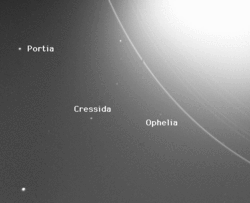Cressida (moon)
- There is also an asteroid called 548 Kressida.
|
| |
| Discovery | |
|---|---|
| Discovered by | Stephen P. Synnott / Voyager 2 |
| Discovery date | January 9, 1986 |
| Orbital characteristics | |
Mean orbit radius | 61,766.730 ± 0.046 km[1] |
| Eccentricity | 0.00036 ± 0.00011[1] |
| 0.463569601 ± 0.000000013 d[1] | |
| Inclination | 0.006 ± 0.040° (to Uranus' equator)[1] |
| Satellite of | Uranus |
| Physical characteristics | |
| Dimensions | 92 × 74 × 74 km[2] |
Mean radius | 39.8 ± 2 km[2][3][4] |
| ~20,000 km²[lower-alpha 1] | |
| Volume | ~260,000 km³[lower-alpha 1] |
| Mass | ~3.4×1017 kg[lower-alpha 1] |
Mean density | ~1.3 g/cm³ (assumed)[3] |
| ~0.013 m/s2[lower-alpha 1] | |
| ~0.034 km/s[lower-alpha 1] | |
| synchronous[2] | |
| zero[2] | |
| Albedo | |
| Temperature | ~64 K[lower-alpha 1] |
|
| |
Cressida (/ˈkrɛsɨdə/ KRES-i-də, Greek: Χρησίδα) is an inner satellite of Uranus. It was discovered from the images taken by Voyager 2 on 9 January 1986, and was given the temporary designation S/1986 U 3.[6] It was named after Cressida, the Trojan daughter of Calchas, a tragic heroine who appears in William Shakespeare's play Troilus and Cressida (as well as in tales by Geoffrey Chaucer and others). It is also designated Uranus IX.[7]
Cressida belongs to the Portia Group of satellites, which includes Bianca, Desdemona, Juliet, Portia, Rosalind, Cupid, Belinda and Perdita.[5] These satellites have similar orbits and photometric properties.[5] Other than its orbit,[1] radius of 41 km[2] and geometric albedo of 0.08[5] virtually nothing is known about it.
At the Voyager 2 images Cressida appears as an elongated object, the major axis pointing towards Uranus. The ratio of axes of the Cressida's prolate spheroid is 0.8 ± 0.3.[2] Its surface is grey in color.[2]
Cressida may collide with Desdemona within the next 100 million years.[8]
See also
References
Explanatory notes
Citations
- ↑ 1.0 1.1 1.2 1.3 1.4 Jacobson, R. A. (1998). "The Orbits of the Inner Uranian Satellites From Hubble Space Telescope and Voyager 2 Observations". The Astronomical Journal 115 (3): 1195–1199. Bibcode:1998AJ....115.1195J. doi:10.1086/300263.
- ↑ 2.0 2.1 2.2 2.3 2.4 2.5 2.6 Karkoschka, Erich (2001). "Voyager's Eleventh Discovery of a Satellite of Uranus and Photometry and the First Size Measurements of Nine Satellites". Icarus 151 (1): 69–77. Bibcode:2001Icar..151...69K. doi:10.1006/icar.2001.6597.
- ↑ 3.0 3.1 3.2 "Planetary Satellite Physical Parameters". JPL (Solar System Dynamics). 24 October 2008. Retrieved 12 December 2008.
- ↑ 4.0 4.1 Williams, Dr. David R. (23 November 2007). "Uranian Satellite Fact Sheet". NASA (National Space Science Data Center). Retrieved 12 December 2008.
- ↑ 5.0 5.1 5.2 5.3 Karkoschka, Erich (2001). "Comprehensive Photometry of the Rings and 16 Satellites of Uranus with the Hubble Space Telescope". Icarus 151 (1): 51–68. Bibcode:2001Icar..151...51K. doi:10.1006/icar.2001.6596.
- ↑ Smith, B. A. (January 16, 1986). "Satellites of Uranus". IAU Circular 4164. Retrieved 29 October 2011.
- ↑ "Planet and Satellite Names and Discoverers". Gazetteer of Planetary Nomenclature. USGS Astrogeology. July 21, 2006. Retrieved 6 August 2006.
- ↑ Duncan, Martin J.; Lissauer, Jack J. (1997). "Orbital Stability of the Uranian Satellite System". Icarus 125 (1): 1–12. Bibcode:1997Icar..125....1D. doi:10.1006/icar.1996.5568.
External links
| |||||||||||||||||||||||||||||||||||||||
| ||||||||||||||||||||||

